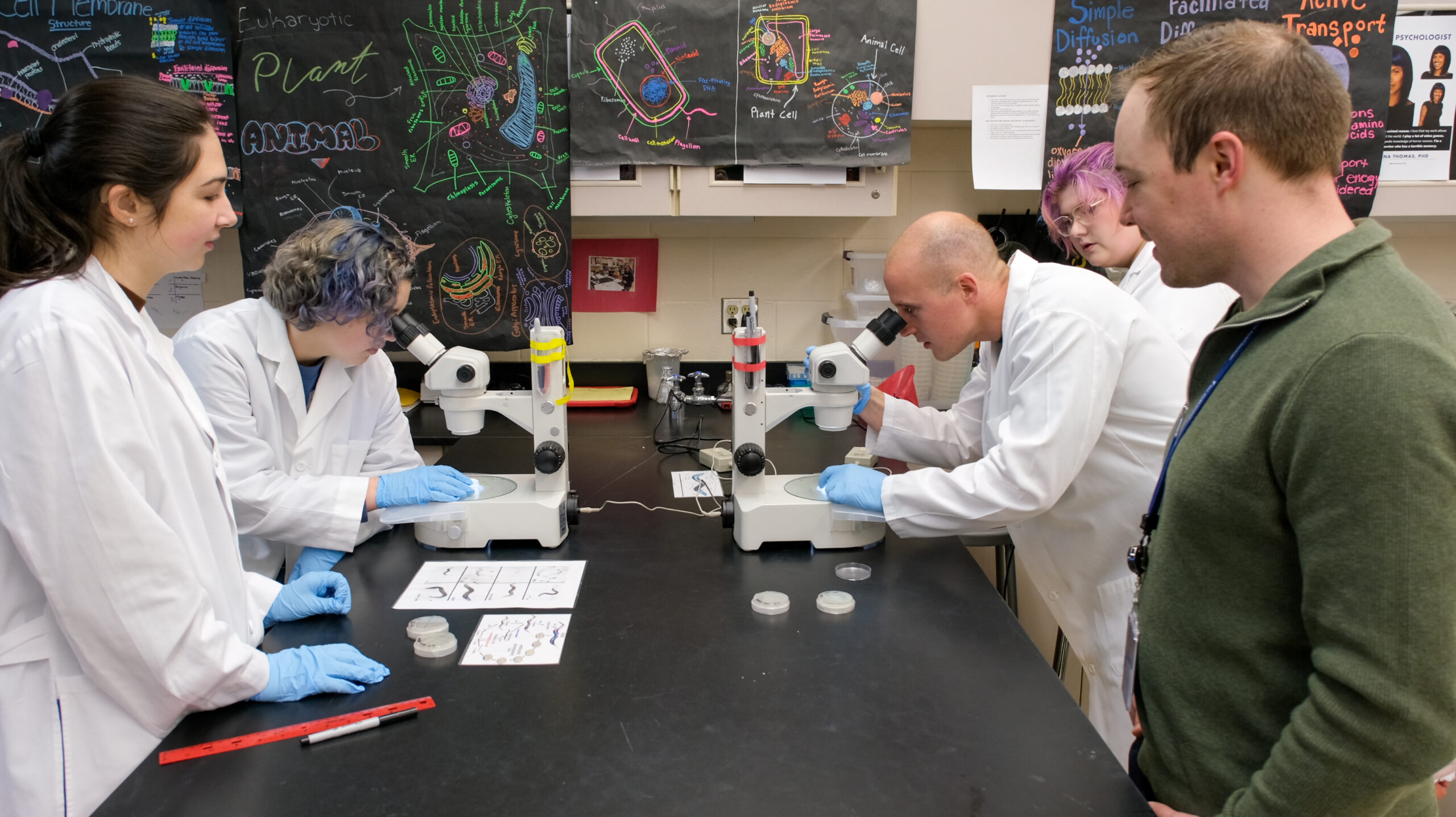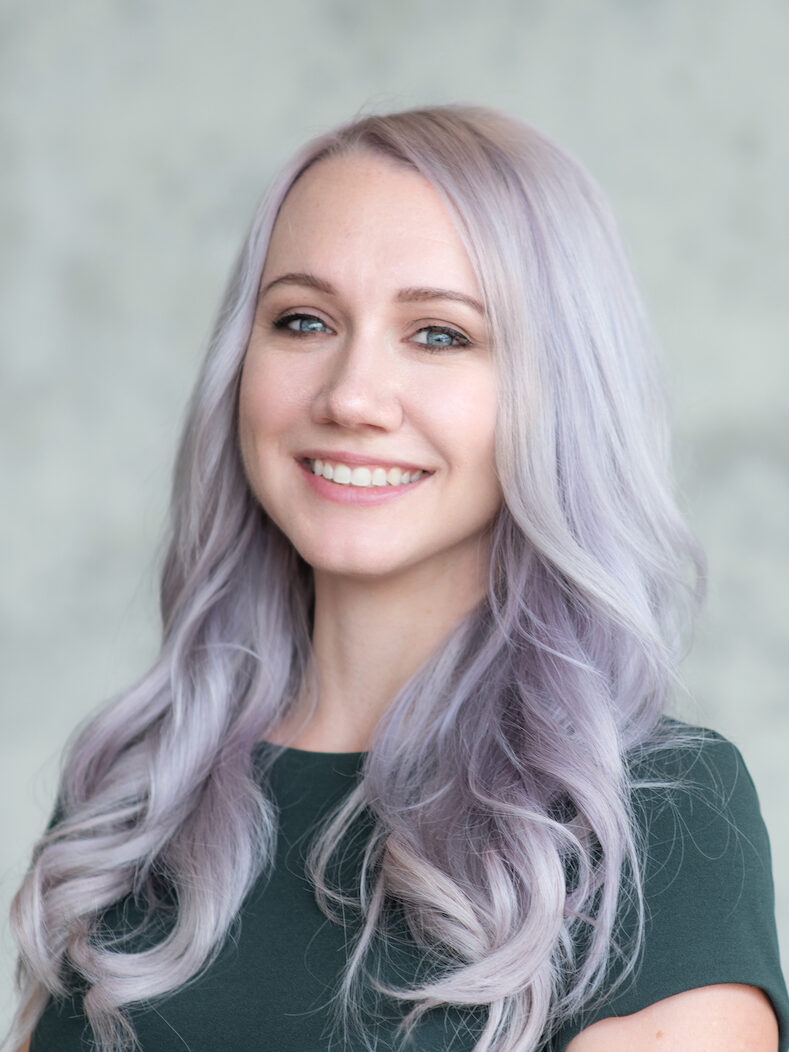Could backyard bacteria and hungry worms help solve a central problem in Type 2 diabetes?
VAI scientists team up with high school students to solve the challenge of insulin resistance
April 25, 2023

Dr. Nick Burton and his team are hunting for a Type 2 diabetes cure in their own backyards.
And in parks.
And in compost piles.
Anywhere with soil, really.
The Burton Lab isn’t tackling this project alone. They enlisted the help of a passionate local science teacher and a trio of tenacious high school students, bringing together the potential of scientific discovery with real-world research experience.
A growing challenge
More than 35 million people in the U.S. — roughly 10% of the population — have Type 2 diabetes, according to the U.S. Centers for Disease Control and Prevention.1 Another 96 million, or 38%, of people aged 18 and older have higher-than-normal blood sugar levels that put them at risk of developing diabetes.1 The long-term consequences can be devastating; unless properly managed, diabetes can cause heart disease, kidney failure, vision loss, and mobility challenges.2
Type 2 diabetes arises when the body faces an influx of sugar over a long period of time. High blood sugar levels are dangerous and damaging, so the body compensates by pushing the pancreas to produce excess insulin, a hormone that keeps blood sugar in check. Much like a biological shepherd, insulin corrals sugar into cells for immediate use or to be stored until needed.
After enough time under these conditions, cells can become insulin resistant — they no longer respond when insulin knocks at the proverbial door, resulting in higher blood sugar levels and, eventually, diabetes.
It’s this issue of resistance that is the focal point of Burton’s work.
“The goal of our project is to design or discover new ways to treat insulin resistance using strategies that already exist in nature,” Burton said. “We just have to find them.”
Latest: Researchers discover two subtypes of insulin-producing cells ➔
Small but mighty
The whole project hinges on worms.
Nematodes to be exact.
They’re called Caenorhabditis elegans, or C. elegans for short. Although small — they’re best viewed under a microscope — they offer scientists a powerful way to study health and sleuth out the causes of disease.
To date, these tiny creatures have racked up an impressive resume: they are responsible for two Nobel Prizes in Physiology or Medicine as well as countless discoveries that shed light on diseases from cancer to neurological disorders. They’re ideal research models because they reproduce quickly, they’re easy to work with and, importantly, they share much of their biology with humans: roughly two-thirds of their genes have a human counterpart.3
“A lot of the basic mechanisms that any animal uses to regulate important things like insulin signaling exists in worms the same way it exists in humans,” Burton explains. “In fact, some of our knowledge about human insulin signaling actually comes from discoveries made in worms.”
Importantly, C. elegans feed on bacteria. They’re not particularly picky eaters, which works out great for Burton and his team, because their project relies on finding microbes that possess a mechanism for combating insulin resistance. The trick is finding the right ones.
That’s where the students come in.
Scientific synergy
Take one step into Heather DeJonge’s classroom at Lowell High School and you know you’re somewhere special.
Student-drawn neon renderings of cells adorn the walls. Above the cabinets, models of the DNA double helix spiral toward the ceiling. A window at the back of the room looks out into a glass-roofed greenhouse filled with student-tended plants.
And then there’s DeJonge herself.
She’s an educational dynamo, a teacher who is deeply invested in fostering curiosity in her students. It’s clear after a few moments of conversation that she does more than teach science.
She lives it.
In summer 2014 and 2015, DeJonge worked at VAI, where she leveraged C. elegans to study impacts of aging on health. Then, in 2021, Burton arrived at VAI as an assistant professor from University of Cambridge in the U.K. He revitalized C. elegans research at the Institute and, during one of VAI’s High School Journal Clubs, met DeJonge.
Together, they created a pilot program that would give students in DeJonge’s class real-world research experience while also helping Burton’s search for an insulin resistance fix.
“There is deep value in students doing authentic research in high school,” DeJonge said. “They can actually contribute to something that’s not well understood yet.”
The project is a far cry from the often-staid experiments that are standard in science curricula across the country. There’s no correct answer and no guarantee that students will find anything. Instead, there is the potential of discovery — and that’s a powerful motivator.
“As a former high school student, I personally wasn’t excited about reproducing experiments when we already knew what the answers were supposed to be. At that point, you just fail or recreate something that’s already happened, but there’s no chance of discovery,” Burton said. “That’s what drives a lot of us who work in the lab everyday — that chance.”
Related: Find out more about VAI’s K-12 Education here ➔
Real research, real impact
Lauren “Ren” Pearson, Faith Van Duinen and McKenna Nietupski don white lab coats before setting petri dishes packed with worms on the benchtop next to their microscopes. For weeks, these intrepid high school students braved the temperamental Michigan autumn to seek out soil samples to mine for bacteria. Some of the samples came from the high school’s lawn. Others hail from the Flat River that meanders through downtown Lowell. Several were sourced from Comstock Park, which borders the northeast side of VAI’s home city of Grand Rapids.
Their guide for the project was Darrick Gates, a research technician in the Burton Lab. Throughout fall 2022, Gates made the half-hour trek to Lowell to help the trio set up experiments, analyze what they’re seeing and talk through next steps.
In their classroom lab, Gates helped the students add the bacteria they gathered to the plates to see how the worms react. Do they go about business as usual? Do they seem more active? Or do they seem sluggish and lethargic?
The worms are canaries in a coal mine, bellwethers for breakthroughs. If insulin-resistant worms get healthier in the presence of certain bacteria, that’s a sign that the microbes could have what it takes to curb insulin resistance.
Regardless of the eventual results, the students say, it’s the journey and the possibility of finding something wholly unique that drives their work.
“It really is a learning process. If you mess up one time, why did you mess up? I like going back to figure out what works and what doesn’t,” Van Duinen said. “That in itself can be an experiment.”
Pearson jumps in: “There’s no wrong answer. There’s just a thousand not-quite-right ones.”
“And on top of that,” Nietupski adds, “I like how there’s always something new. There will always be things that have not been discovered yet.”
From Lowell to the lab
Back at VAI, Gates and Burton gathered around a glowing computer monitor depicting a split-screen of two groups of worms, their images projected from a pair of plates sitting under a nearby microscope.
Half are healthy and writhing. The other half are listless.
All of them offer clues into the innerworkings of insulin resistance.
While the students were hard at work in Lowell, Burton’s lab tackled the technical aspects of the project. This includes screening soil samples to identify known microbes and flag new ones. The most promising sample came from close to home — a compost pile in Gates’ backyard.
So far, the Burton Lab has found three bacteria with the potential to impact insulin resistance. The work is far from over — fully analyzing each one is an arduous process that can take a year or more.
“Our dream is that we characterize these bacteria, and we find something that works,” Burton said. “In the long term, we want to translate our basic findings from the lab into the clinic where we can actually help people.”
There is deep precedent for mining bacteria for new medicines. The antibiotics streptomycin, vancomycin and tetracycline were all derived from soil bacteria.4 Rapamycin, which helps prevent rejection in organ transplants and has anti-cancer properties, was isolated from a bacterium dug from the soil of Rapa Nui, also known as Easter Island.5 The chemotherapy agent bleomycin was discovered by scientists after screening Streptomyces bacteria in search of a species that could be used in drug development.6
That’s the kind of breakthrough Burton and his team are working toward. They’ve already had some exciting early results that Burton hopes to publish in a scientific journal sometime in the next year. Although the findings aren’t ready to be shared yet, the nature of research offers a tantalizing promise for what’s to come.
The start of something big
In many ways, this project is only the beginning.
The beginning of a possible new way to treat insulin resistance and, with it, Type 2 diabetes.
The beginning of a collaboration designed to inspire curiosity.
And, for many, the beginning of a fresh way to think about the ground beneath our feet.
The power of science is rooted in the unknown and what we might find when we take the simple step of asking a question. For the students, the chance to contribute to real research has opened a new world of possibility, one that offers revelations for those who choose to search.
“There really aren’t a ton of other schools that do what we’re doing with this,” said Pearson. “This has been an incredible opportunity to do some real scientific exploration in a setting where we’re supported by teachers, peers and incredible scientists.”
As the analysis continues in Burton’s lab, there is a current of excitement, a constant hum of possibility that something unexpected could be right around the corner. What if a simple clod of dirt and the microbes within — from Lowell, from Grand Rapids, from Rockford — could be the key to a life-changing breakthrough?
“The possibilities are endless,” Burton said. “I can’t wait to see what comes next.”
Sources
1 Centers for Disease Control and Prevention. 2022. Type 2 diabetes. https://www.cdc.gov/diabetes/basics/type2.html
2 Centers for Disease Control and Prevention. 2022. National Diabetes Statistics Report. https://www.cdc.gov/diabetes/data/statistics-report/index.html
3 Zhang S, Li F, Zhou T, Wang G, Li Z. 2020. Caenorhabditis elegans as a useful model for studying aging mutations. Front Endocrinol 11.
4 Li W. 2020. Bacteria: The drug factory you’d never expect. Harvard University Science in the News. https://sitn.hms.harvard.edu/flash/2020/bacteria-the-drug-factory-youd-never-expect/
5 Seto B. 2012. Rapamycin and mTOR: a serendipitous discovery and implications for breast cancer. Clin Transl Med 1:29.
6 American Chemical Society. 2020. Bleomycin. https://www.acs.org/molecule-of-the-week/archive/b/bleomycin.html

